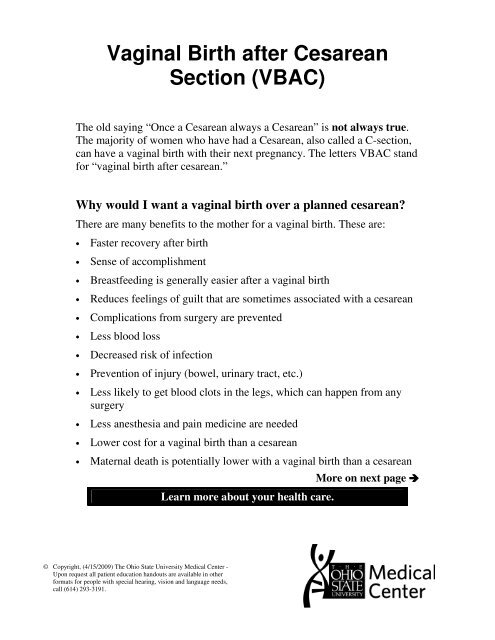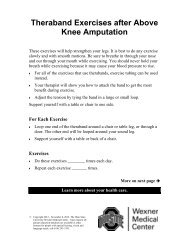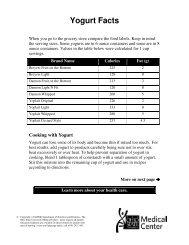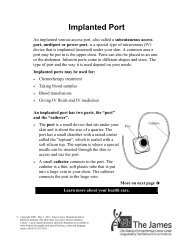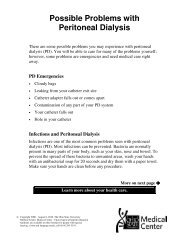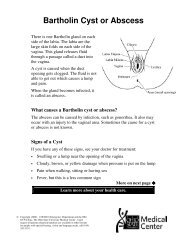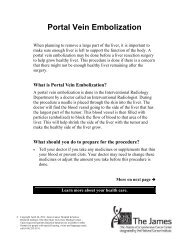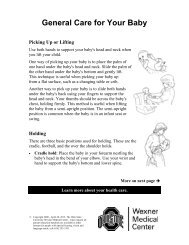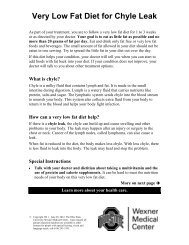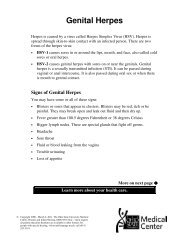English - Patient Education Home
English - Patient Education Home
English - Patient Education Home
You also want an ePaper? Increase the reach of your titles
YUMPU automatically turns print PDFs into web optimized ePapers that Google loves.
Vaginal Birth after Cesarean<br />
Section (VBAC)<br />
The old saying “Once a Cesarean always a Cesarean” is not always true.<br />
The majority of women who have had a Cesarean, also called a C-section,<br />
can have a vaginal birth with their next pregnancy. The letters VBAC stand<br />
for “vaginal birth after cesarean.”<br />
Why would I want a vaginal birth over a planned cesarean?<br />
There are many benefits to the mother for a vaginal birth. These are:<br />
• Faster recovery after birth<br />
• Sense of accomplishment<br />
• Breastfeeding is generally easier after a vaginal birth<br />
• Reduces feelings of guilt that are sometimes associated with a cesarean<br />
• Complications from surgery are prevented<br />
• Less blood loss<br />
• Decreased risk of infection<br />
• Prevention of injury (bowel, urinary tract, etc.)<br />
• Less likely to get blood clots in the legs, which can happen from any<br />
surgery<br />
• Less anesthesia and pain medicine are needed<br />
• Lower cost for a vaginal birth than a cesarean<br />
• Maternal death is potentially lower with a vaginal birth than a cesarean<br />
© Copyright, (4/15/2009) The Ohio State University Medical Center -<br />
Upon request all patient education handouts are available in other<br />
formats for people with special hearing, vision and language needs,<br />
call (614) 293-3191.<br />
Learn more about your health care.<br />
More on next page
Page 2<br />
There are also benefits for the baby with a vaginal birth. These are:<br />
• Less risk of early delivery<br />
• Labor prepares the baby for life outside the womb<br />
• Fewer breathing problems<br />
• More opportunities for mother-baby bonding<br />
How do I know if I can have a vaginal birth?<br />
Talk with your doctor about your ability to have a vaginal birth.<br />
• If you had a prior C-section and had a low transverse incision, you may<br />
be able to have a VBAC.<br />
• If you previously had a cesarean because your baby was in either a<br />
breech position (feet first) or there were concerns about the baby’s<br />
health during prior labor, you may be able to have a VBAC. For other<br />
reasons for which your prior cesarean was performed, talk with your<br />
doctor about your ability to have a VBAC.<br />
• If you are willing to prepare for a VBAC and accept the risks of a<br />
VBAC you may be able to do so.<br />
How do I know if I should have a repeat cesarean?<br />
Talk with your doctor about concerns with a VBAC.<br />
• Some women prefer a scheduled, repeat cesarean.<br />
• Women with a vertical uterine incision should not have a VBAC.<br />
• Scheduled repeated C-section reduces the risk of uterine rupture during<br />
an attempted VBAC which can potentially harm the mother and baby.<br />
How can I prepare for a VBAC?<br />
There are things you can do to prepare for a VBAC:<br />
• Read about vaginal births after a cesarean so that you understand your<br />
options and know the statistics associated with VBAC and repeat<br />
cesarean delivery.
• Discuss the benefits and possibility of a VBAC with your health care<br />
provider.<br />
Find out why you had a prior cesarean<br />
Talk about a birth plan with your health care provider<br />
Talk to others about their experiences with VBAC<br />
Page 3<br />
• Prepare physically for a VBAC. Labor is the hardest work you will ever<br />
do. Exercise regularly and eat healthy foods.<br />
• Take prenatal classes. Learn about the birthing experience.<br />
Read about birth preparation.<br />
Talk with your health care provider about prenatal education.<br />
Contact the hospital where you are planning to deliver to register for<br />
a VBAC class, refresher course or other preparation for your and<br />
your partner.<br />
• Believe in yourself, your body and the process of birth.<br />
Be proactive and talk about pain medicine options during birth with<br />
your health care provider.<br />
Confront any negative emotions you may have from the prior<br />
cesarean birth. Some women experience guilt or disappointment.<br />
Develop positive feelings about the birthing process.<br />
Reassure family and friends about the safe decisions you are making<br />
for your and your baby.<br />
Books and Resources for Cesarean and Vaginal Birth After<br />
Cesarean<br />
There are many resources available to help you with your choice and<br />
planning of a VBAC. Here is a list of some resources which are available at<br />
your local library, bookstores, or hospital education centers.<br />
• Birth After Cesarean by Dr. Bruce Flamm<br />
• The VBAC Companion: The Expectant Mother’s Guide to Vaginal<br />
Birth After Cesarean by Diana Korte<br />
• www.acog.org for information about VBAC (from The American<br />
College of Obstetricians and Gynecologists)


